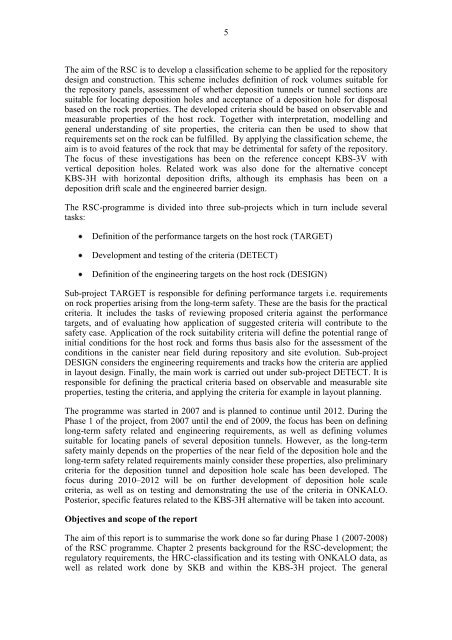RSC-Programme - Interim Report. Approach and Basis for - Posiva
RSC-Programme - Interim Report. Approach and Basis for - Posiva
RSC-Programme - Interim Report. Approach and Basis for - Posiva
Create successful ePaper yourself
Turn your PDF publications into a flip-book with our unique Google optimized e-Paper software.
5The aim of the <strong>RSC</strong> is to develop a classification scheme to be applied <strong>for</strong> the repositorydesign <strong>and</strong> construction. This scheme includes definition of rock volumes suitable <strong>for</strong>the repository panels, assessment of whether deposition tunnels or tunnel sections aresuitable <strong>for</strong> locating deposition holes <strong>and</strong> acceptance of a deposition hole <strong>for</strong> disposalbased on the rock properties. The developed criteria should be based on observable <strong>and</strong>measurable properties of the host rock. Together with interpretation, modelling <strong>and</strong>general underst<strong>and</strong>ing of site properties, the criteria can then be used to show thatrequirements set on the rock can be fulfilled. By applying the classification scheme, theaim is to avoid features of the rock that may be detrimental <strong>for</strong> safety of the repository.The focus of these investigations has been on the reference concept KBS-3V withvertical deposition holes. Related work was also done <strong>for</strong> the alternative conceptKBS-3H with horizontal deposition drifts, although its emphasis has been on adeposition drift scale <strong>and</strong> the engineered barrier design.The <strong>RSC</strong>-programme is divided into three sub-projects which in turn include severaltasks:Definition of the per<strong>for</strong>mance targets on the host rock (TARGET)Development <strong>and</strong> testing of the criteria (DETECT)Definition of the engineering targets on the host rock (DESIGN)Sub-project TARGET is responsible <strong>for</strong> defining per<strong>for</strong>mance targets i.e. requirementson rock properties arising from the long-term safety. These are the basis <strong>for</strong> the practicalcriteria. It includes the tasks of reviewing proposed criteria against the per<strong>for</strong>mancetargets, <strong>and</strong> of evaluating how application of suggested criteria will contribute to thesafety case. Application of the rock suitability criteria will define the potential range ofinitial conditions <strong>for</strong> the host rock <strong>and</strong> <strong>for</strong>ms thus basis also <strong>for</strong> the assessment of theconditions in the canister near field during repository <strong>and</strong> site evolution. Sub-projectDESIGN considers the engineering requirements <strong>and</strong> tracks how the criteria are appliedin layout design. Finally, the main work is carried out under sub-project DETECT. It isresponsible <strong>for</strong> defining the practical criteria based on observable <strong>and</strong> measurable siteproperties, testing the criteria, <strong>and</strong> applying the criteria <strong>for</strong> example in layout planning.The programme was started in 2007 <strong>and</strong> is planned to continue until 2012. During thePhase 1 of the project, from 2007 until the end of 2009, the focus has been on defininglong-term safety related <strong>and</strong> engineering requirements, as well as defining volumessuitable <strong>for</strong> locating panels of several deposition tunnels. However, as the long-termsafety mainly depends on the properties of the near field of the deposition hole <strong>and</strong> thelong-term safety related requirements mainly consider these properties, also preliminarycriteria <strong>for</strong> the deposition tunnel <strong>and</strong> deposition hole scale has been developed. Thefocus during 2010–2012 will be on further development of deposition hole scalecriteria, as well as on testing <strong>and</strong> demonstrating the use of the criteria in ONKALO.Posterior, specific features related to the KBS-3H alternative will be taken into account.Objectives <strong>and</strong> scope of the reportThe aim of this report is to summarise the work done so far during Phase 1 (2007-2008)of the <strong>RSC</strong> programme. Chapter 2 presents background <strong>for</strong> the <strong>RSC</strong>-development; theregulatory requirements, the HRC-classification <strong>and</strong> its testing with ONKALO data, aswell as related work done by SKB <strong>and</strong> within the KBS-3H project. The general
















